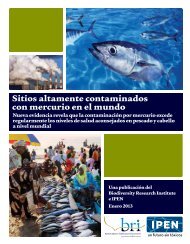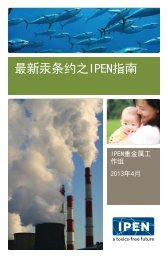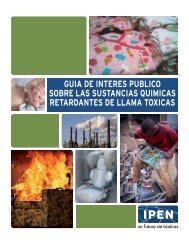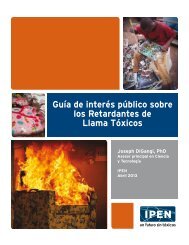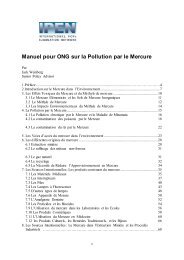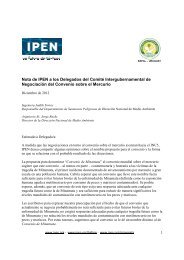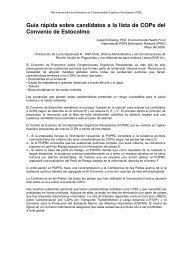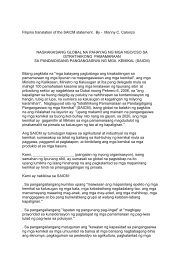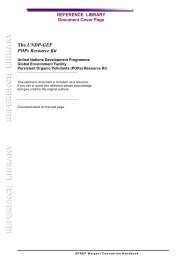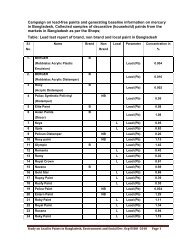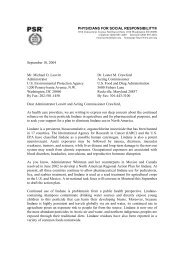A Public Interest Guide to Toxic Flame Retardant Chemicals
A Public Interest Guide to Toxic Flame Retardant Chemicals
A Public Interest Guide to Toxic Flame Retardant Chemicals
You also want an ePaper? Increase the reach of your titles
YUMPU automatically turns print PDFs into web optimized ePapers that Google loves.
warranted. This conclusion means that the<br />
treaty expert committee considers HBCD<br />
<strong>to</strong> be a persistent organic pollutant (POP)<br />
and one of the world’s worst chemicals.<br />
7.5 NORWAY PLANS TO ELIMINATE<br />
BROMINATED FLAME RETARDANTS<br />
BY 2020<br />
PentaBDE, OctaBDE, DecaBDE, and PBB<br />
are currently banned in Norway. The<br />
industry has voluntarily withdrawn HBCDcontaining<br />
insulation from the market<br />
in Norway and Sweden since alternative<br />
construction techniques with the chemicals<br />
provided a safer alternative. Waste<br />
that contains 0.25% or more PentaBDE,<br />
OctaBDE, DecaBDE, HBCD or TBBPA is<br />
defined as hazardous waste. New flame<br />
retardants are currently under investigation.<br />
Norway has established a priority list<br />
for phase-out of all emissions and uses for<br />
the purpose of eliminating them by 2020.<br />
The list includes flame retardant chemicals<br />
such as PentaBDE, OctaBDE, DecaBDE,<br />
HBCD, and TBBPA. Other substances on<br />
the list include bisphenol A, DEHP, SCCPs,<br />
PFOA, PFOS, perchloroethylene, trichloroethylene,<br />
and triclosan.<br />
7.6 THE EUROPEAN UNION (EU) HAS<br />
BANNED SOME FLAME RETARDANT<br />
CHEMICALS<br />
PentaBDE, OctaBDE and hexabromobiphenyl<br />
are banned in the EU. The European<br />
Chemical Agency identified TCEP as a<br />
Substance of Very High Concern with a<br />
sunset date of 2015. DecaBDE is prohibited<br />
in electronics, but permitted in other uses.<br />
Other flame retardants used in electronics<br />
such as TBBPA are permitted. Electronic<br />
waste containing these flame retardants<br />
often finds its way <strong>to</strong> dump sites in Africa<br />
and Asia, often in the form of near-end-oflife<br />
products that rapidly become wastes<br />
after entry in<strong>to</strong> the country.<br />
7.7 A WEAK CHEMICAL REGULATORY<br />
POLICY PERMITS NEW TOXIC FLAME<br />
RETARDANTS TO BE ADDED TO<br />
CONSUMER PRODUCTS<br />
The 1976 US regula<strong>to</strong>ry law on chemicals<br />
is weak, outdated, and does not protect<br />
human health. However it is often used as<br />
a model for policy in developing and transition<br />
countries. The EPA admitted <strong>to</strong> the<br />
Chicago Tribune that “…it is largely powerless<br />
<strong>to</strong> do anything about chlorinated tris<br />
[carcinogen in children’s products]. The<br />
agency cited industry’s continued use of<br />
the chemical as a stark example of why<br />
it supports’ much needed reform’ of the<br />
nation’s chemical safety law.” The Chicago<br />
Tribune noted that the 1970s <strong>Toxic</strong> Substances<br />
Control Act (TSCA), “…allows manufacturers<br />
<strong>to</strong> sell products without proving<br />
they are safe and <strong>to</strong> treat the formulas as<br />
trade secrets. Once health effects are documented,<br />
the law makes it almost impossible<br />
for the EPA <strong>to</strong> ban chemicals…To ban<br />
a chemical already on the market, the EPA<br />
must prove that it poses an ‘unreasonable<br />
risk’. Federal courts have established such<br />
a narrow definition of ‘unreasonable’ that<br />
A PUBLIC INTEREST GUIDE TO TOXIC FLAME RETARDANT CHEMICALS<br />
19



